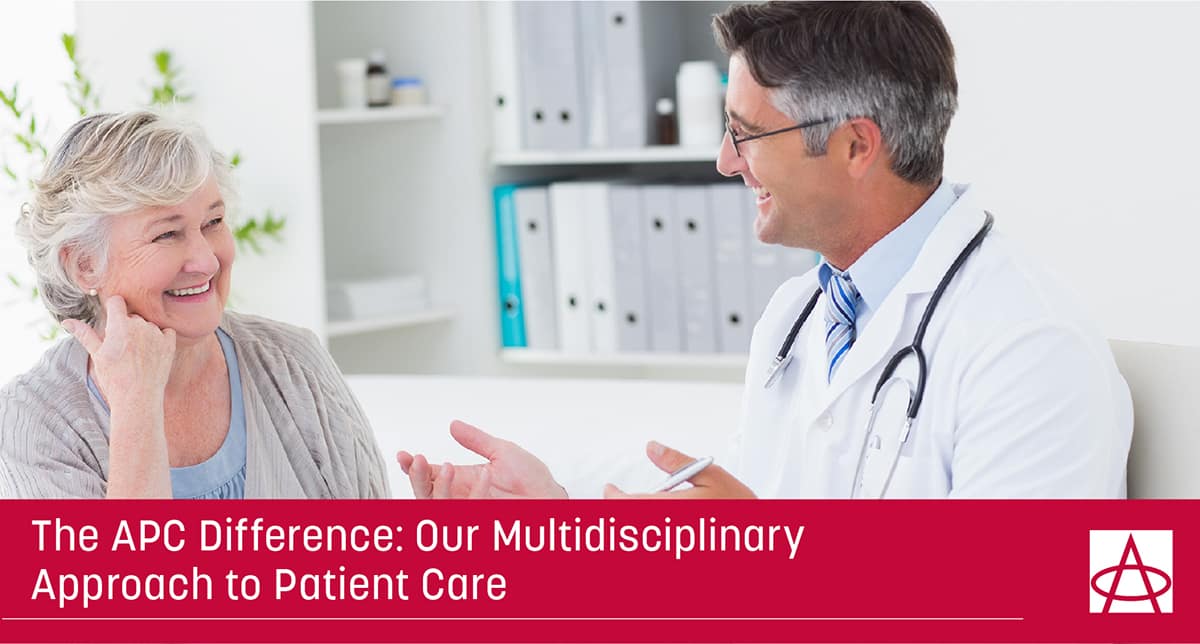
The APC Difference: Our Multidisciplinary Approach to Patient Care
By Dr. Mark Malone, Founder of Advanced Pain Care
When you walk through the doors at Advanced Pain Care, I want you to feel happy and optimistic. Everyone at APC brings a positive attitude to their work, and we want you to feel the same way we do.
I know you’re in some form of pain when you visit us. I know that’s an unpleasant experience. Feeling happy and optimistic isn’t a typical feeling for most chronic pain patients.
That’s why I created Advanced Pain Care: I saw a need for comprehensive and compassionate patient care.
And my own personal experience as a pain patient showed me just how powerful that mission is.
What Inspired You to Create Advanced Pain Care?
I once worked as an anesthesiologist in a busy hospital, doing a lot of orthopedic and spine cases.
I did a lot of spinal fusions, spinal decompressions, total joint replacements, and open reduction internal fixation of fractures.
And I learned over the years that there’s a huge demand for chronic pain management in these patients and others.
Many patients have spinal surgery because of back pain. Sometimes surgery doesn’t make it any better, and actually makes it worse.
I saw patients come in for repeated surgeries. After three or four spinal surgeries, they had little chance of getting better as a result of surgery.
I also knew a number of doctors in other specialties, including chronic pain management.
Their clinics and pain management organizations were woefully inadequate to treat the epidemic of chronic spinal pain and orthopedic pain that I was witnessing as a doctor.
So I investigated further. I contacted friends with whom I trained at Baylor College of Medicine in Houston and arranged to do a fellowship in chronic pain management.
When I finished that fellowship in 1998, I came back to Austin and opened my first clinic: Advanced Pain Care.
What began as a part-time effort grew to 60-hour workweeks trying to manage chronic pain patients. So I hired staff and opened a full-time clinic.
The rapid growth of my business showed me how essential this service is in the medical community.
What Makes APC’s Multidisciplinary Approach so Unique?
Something we say at APC is that pain is inevitable, but suffering is optional. That’s one of my core beliefs. We have the technology today to not only control but to cure chronic pain.
There’s no need to suffer from pain like so many have for decades (even centuries).
That’s a belief we all share at APC, which also informs our multidisciplinary approach to patient care; One single specialist can’t possibly manage everything that should go into the modern management of chronic pain.
That’s why I intentionally created a practice that included multiple specialties, especially neurosurgery, orthopedics, and rheumatology.
In my training, I learned about the essential elements of multidisciplinary pain management. Traditionally the three areas of focus are pain management, psychology, and physical therapy.
APC expounds on that foundation by adding more specialties, including neurosurgery because much of what we do can be approached in more than one way.
Neurosurgeons are very good at looking at chronic pain, nerve damage, and spinal damage, from a neurosurgical perspective.
That perspective is a huge help to us. It adds another dimension in approaching complex spinal cases.
Providing more specialists under one roof solves one of the biggest problems in pain management: efficient communication.
Coordinating communication among multiple specialists at different locations is incredibly challenging.
Typically, when a patient needs to see a neurosurgeon, it takes weeks and sometimes a month to get the patient to that first appointment.
I realized that the fastest way to cut through all of that red tape was to bring neurosurgeons to the APC practice. Rheumatology is another critical element in patient care that I integrated at APC.
It’s incredibly efficient when we as doctors can conference together in the same clinic, in the same conference room.
Often we can see our patients at the same time, which is a revelation to patients.
They don’t believe that this is even possible.
It’s never been done before, and they’re extremely overwhelmed and grateful when they can see a neurosurgeon and a pain specialist at the same time.
Related: Find Your Preferred Advanced Pain Care Location
How do Patients and Doctors Benefit from APC’s Multidisciplinary Approach?
Cutting through the red tape and communication difficulties is a great benefit for everyone.
Another issue in today’s medical world is technology-driven.
Doctors, hospitals, and clinics all use electronic medical records (EMRs).
But these EMRs all reside on different systems, and the systems don’t talk to each other.
You can imagine the level of frustration that causes nurses, doctors, and administrators.
But at APC, we are all on the same EMR system at every clinic location.
We can print or view digitally all of your relevant records spanning neurosurgery, rheumatology, psychology, pain management — even our Advanced Rx pharmacy and laboratory.
Having immediate access to pharmacy records and lab results makes our patient care even more efficient.
We don’t leave anything critical out of the process in assessing and treating our patients.
What’s the Pain Treatment Process Like at APC?
One of the biggest questions in chronic pain is whether the patient needs surgery or not. (Most often that means spinal surgery.)
I’ve seen patients with life-changing back pain — pain so severe that they can’t walk or get out of bed.
These patients need to know if surgery is necessary, or if other kinds of pain management are feasible, like epidural steroid injections, physical therapy, and medication treatment.
If you’re one of those patients, you can be seen by multiple specialists during the same visit.
Sometimes two or three doctors will put their heads together and ask themselves: “What is the absolute best next step for this patient?”
These doctors can come to a decision, discuss it with the patient, and immediately take the next step.
The efficiency of this collaborative decision-making is huge for our chronic pain patients.
They’re used to going to multiple doctors at different clinics with different computer systems.
That’s what makes APC’s multidisciplinary approach so effective for patients and practitioners alike.
Are There Any Advanced Methods of Pain Treatment You Offer?
Total joint replacement and spinal cord stimulation are two vastly improved procedures and technologies that we offer at APC.
A huge cause of chronic pain in the older population is total joint replacement, especially total knee replacement.
These joint replacement surgeries have become much safer, much less invasive — they’re almost bloodless — resulting in much shorter recovery times for patients.
In fact, they’re done mostly as outpatient procedures.
We at APC offer this type of rapid recovery total joint replacement.
The three joints we specialize in are knees, hips, and shoulders.
Patients have very little pain or discomfort. They get special nerve blocks that relieve pain for up to three days. Patients are walking on their new joint and going home on the same day.
That’s a great advance.
I’m 65. When the time comes and I need a total knee replacement, I’m really glad to know that it’s a good option for me.
Continued refinement in spinal stimulation is still the biggest story in the field of pain management. The stimulator is much easier to implant in the body with advanced surgical techniques.
There are so many people who can benefit from spinal cord stimulation. Everything from headache to peripheral neuropathy — any kind of nerve damage — we’re able to treat, sometimes with 100 percent effectiveness.
Related: Spinal Cord Stimulation: A Tried and True Pain Relief Technology
Do You Have Any Personal Experience as a Pain Patient?
I never thought I myself would ever be a chronic pain patient. I’ve always led a healthy and active life.
I was a college athlete. I was on the judo team at the University of Texas. I was an avid water skier, wakeboarder, snow skier, snowboarder, and weightlifter.
Of course, athletes experience some pain as a part of their activity. I had a few back pains, aches, and pains over the years, just like anyone.
But about 12 years ago, I did something that many people do, though it’s ill-advised. I tried lifting something heavy.
I turned and twisted my lower back awkwardly when I felt a pop and a tremendous pain.
I fell to the ground, and my back wasn’t the same after that. The pain got worse, and I was unable to walk more than a few minutes at a time.
I had to quit my job, and I was out of work for an entire year on disability laying in bed. Most of the time I was on chronic pain medicine. I had spinal injections and physical therapy.
Eventually, I got two back surgeries out of desperation, even though I knew they weren’t guaranteed to help me.
I was able to recover enough to work part-time for a few years. I was just limping along with that pain until about four years ago.
That’s when the new spinal stimulators came out from some of the best companies in the world. We started using these devices on more patients and getting great results.
So I had one of my doctors install one of these stimulators in my own back.
It was like turning off a light switch. The pain was gone as soon as I woke up from the procedure.
Since then I’ve been fully functioning, back to normal. I’m able to work 12 to 15 hours a day if I want. I’m just completely celebrating my new life. I’m the world’s foremost poster boy for spinal simulators.
My case illustrates very well to me and to all of my fellow APC practitioners that many of our chronic pain patients are miserable. They can barely walk. They can’t function.
Many times there’s no obvious reason for your pain, nothing an MRI can explain.
It can be hard to get a doctor to believe you. Sometimes even your family doesn’t believe that you’re really in so much pain that you can’t go to work.
So telling a patient that we believe them when they say they’re in pain — that’s such a relief to them.
When you come to APC you will talk to pain care professionals who believe you. We’re going to treat you honestly, with compassion and respect. We’ll use all of our available resources to alleviate your pain.
We want to be the final stop on your road to complete chronic pain recovery.






